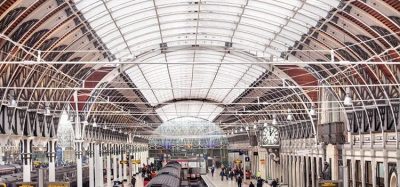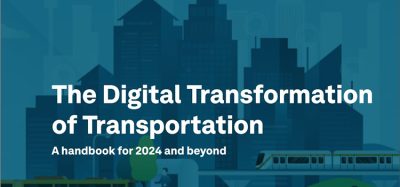The ÖBB life cycle cost
Posted: 23 August 2005 | | No comments yet
In a joint project, Austrian Federal Railways (ÖBB), the Institute for Railway Engineering and Transport Economy of the University of Technology, Graz and voestalpine Schienen GmbH have developed a (LCC) life cycle cost-based evaluation model for track components – rail profiles and steel grades.
In a joint project, Austrian Federal Railways (ÖBB), the Institute for Railway Engineering and Transport Economy of the University of Technology, Graz and voestalpine Schienen GmbH have developed a (LCC) life cycle cost-based evaluation model for track components – rail profiles and steel grades.
In a joint project, Austrian Federal Railways (ÖBB), the Institute for Railway Engineering and Transport Economy of the University of Technology, Graz and voestalpine Schienen GmbH have developed a (LCC) life cycle cost-based evaluation model for track components – rail profiles and steel grades.
Using this model, optimum fields of application and maintenance procedures of different rail profiles and steel grades are identified for various track conditions. Value to customers is achieved by providing assistance for railroaders in terms of minimal LCC based decisions for investment and maintenance.
From the ‘Track Strategy’ project of the Institute and ÖBB, a life cycle cost-based track maintenance system has emerged1-3. The basic idea was to produce cost-effective strategies optimised in relation to life cycle costs, adapted to take account of actual measurement results and the present status of track. Within this project a number of different investment and maintenance options were evaluated from an economic perspective to define basic strategies.
Railroads are facing the rail damage characteristics by their internal regulations that define which steel grade and rail profile respectively must be used under specific load and track conditions. These regulations are based on technical experiences in the field. As a recess of the track strategy project, the LCC based consideration of the track was broken down to track components4. It was the aim of the new project to identify optimal fields of application of different rail profiles and steel grades from an economical point of view. Comparative cost evaluations of different rail profiles and rail steel grades can be carried out by an advanced software model for LCC evaluation5. Technical advantages of head hardened rails (HSH®), obtained in several track test sections, were considered to identify best practise technology additionally6-10. Furthermore, today’s maintenance strategies were investigated and potential for optimisation was gained.
Project and LCC-model description
The economic evaluation was carried out from the point of view of the user disposing a life cycle cost based evaluation model for the whole track.
Typical track situations have been analysed in line with the basic strategies, taking differences due to different types of rails into account. These specific track situations are described including their schedule for the planned maintenance work and statistic cost figures for spot repair in so-called working cycles (Figures 1 and 3). These cycles, evaluated for track sections on good subsoil conditions4, using good ballast qualities, a maximum axle load of 22.5 tons and a maximum speed of 160km/h are specified due to differences in:
- Transport volumes (between 18,000 and 80,000 gross tons per day and track)
- Different alignment (radii below 250m to straight sections)
- Rail profiles (60E1, 54E2, 49E1)
- Steel grades (R200, R260, R350HT)
The working cycles are based on the technical effects of the use of different rails in the various standard situations and verified by the experiences of ÖBB in general use and test sections. Calculating investment and maintenance costs, including the costs of operational hindrances due to maintenance actions, allowed presenting the life cycle cost of different track types. They are therefore based on the Austrian cost levels (2004) reflecting the Austrian experiences. Within the economic evaluation, the average annual costs, calculated with a rate of interest of five per cent net, are compared for the different standard situations.
The evaluation of absolute life cycle cost is problematical because of uncertainties in precise cost predictions over long periods, i.e. life cycle costs are not stable over long periods. Therefore the decisions are based here on comparing life cycle cost, because differences of life cycle costs, answering the question which solution is the preferable one, are stable.
Two maintenance cycles are presented in figure 1. The upper cycle is describing the required actions for one track of a double track line with 80,000 gross tons per day and track, (maximum speed of 160km/h) radii between 400m and 600m and continuous welded 60kg rails (60E1) on concrete sleepers. The track is tamped every second year, rails are ground every fourth year and only 30 per cent of the rails are changed. As a result, the average life span of this track section is 22 years.
Using lighter rails under these conditions, some effects have to be taken into account, thus: The life span of 49kg rails is limited according to ÖBB regulations to 280 million gross tons due to the risk of fatigue failure11. Therefore a complete change of rails is implemented in the respective cycle in the tenth year. The lighter track shows less long term stability resulting in increased tamping demands.
Furthermore, the lifespan of track is limited by the ballast bed quality which is influenced by dynamic loads of traffic and by tamping. Figure 2 shows the relation between tamping cycle and track life time based on experiences of track sections on good subsoil conditions.
The relation shows that an increase of tamping cycles of x%, achieved by using innovative components or optimised maintenance actions without reducing track quality, increases the life span of track from x/3% to x/4%. This relation results in a remarkable reduction of track life span using 49kg rail as proved by experience. Within the study, cycles like this have been discussed, verified and used for the economic evaluation.
Figure 3 shows different cycles for rails with different steel grades. The cycles are based on the use of 60kg rails; the alignment shows radii less than 250m. Therefore the rails are fish- plated and laid on wooden sleepers. The exigent alignment results in high maintenance effort and a relatively short life span of track. The technical effects taken into account are differences in wear and tear of rail resulting in different life span of rails and different grinding demands. The nature of wear is mainly side wear in sharp curves. The vertical wear also shows differences, but rails need to be changed because of horizontal wear. There is a clear positive effect on wear reduction of using the high strength steel grades up to radii of about 500m. The improvement factor of two is less than those observed by other railways9,10. The methods of track operation in Austria are obviously beneficial to this situation:
- In smaller radii a preventive grinding programme is executed
- All locos are equipped with flange lubrication
ÖBB takes care of this situation by using the head hardened rails (R350HT) in all sections with radii below 350m on a regular basis.
Up to now the RCF-problem is, fortunately, not really an issue in Austria13. Discussing possible reasons for this preferable situation in Austria, a lot of arguments can be mentioned, without balancing them:
- Grinding new rails as standard part of track laying produces good rail-wheel contact conditions
- The track is maintained to a high quality level, the main strategy is to reduce life cycle costs by the positive effects of high track quality
- Track allows high elasticity by its constructive principle (vertical elastic settlements under the wheel of 1.5mm)
- High powered locomotives with respective high slip are in use only for a few years
- There are no experiences over longer periods for speeds higher than 200km/h
Consequently the positive effect of the use of high strength steel grades on RCF in larger curves (~ 500m and more), as reported by many other railways6, 12 are not reflected in the cycles. Keeping these restrictions in mind, the results of all the economic evaluations are shown in the following.
Results
For all track sections allowing continuous welded track and facing a transport of more than 18,000 gross ton per day, 60kg rails on concrete sleepers are preferable.
In sharp curves with radii less than 250m fish plated rails on wooden sleepers should be used. Down to transport volumes of 25,000 gross tons per day, 60kg rails are again preferable; for less transport, 54kg rails are proposed; for branch lines even 49kg rails are sufficient.
The conclusion on the steel grade choice for Austrian conditions is as follows. In general, rails of the steel grade R260 are used. For radii less than 500m rails of the steel grade R350HT show better economical results, because of the significant reduction of wear. Savings of annual average life cycle cost of track superstructure of R350HT compared to R260 are given in table 1.
All discussions referring to RCF show that head hardened rails can reduce this problem4, 6, 7, 8, 10, 13 but an economic evaluation was not possible due to lack of experience with RCF in the network of ÖBB.
Sensitivity analyses needs to be part of experience driven evaluation models. Consequently, main input data have been varied. The results have been proven stable even varying the labour cost between 15 per cent and 200 per cent. The costs of operational hindrances are calculated very specific country wise and in any case refer to the operational conditions of the respective network. Thus they have been varied from 0 per cent to 500 per cent, influencing the life cycle cost in a wide range but not the rankings. However, within the most important sensitivity analysis an optimistic and a pessimistic scenario have been worked out for all standard situations. The aim of these cycles is to cover the variety of track behaviour due to the experiences of the network, but still under the precondition of good subsoil conditions14. The cycles differed in life time of track from -25 per cent to +30 per cent and respective changes in tamping cycles, spot repair cost etc. Although these cycles reflect a wide range of track behaviour, the optimistic scenarios do not influence the results at all, the pessimistic ones show rails with higher steel grades in favour.
Quality of rail welds is important, both technically and economically, because welds with poor quality increase the danger of rail breakage and are reason for single failures.
Outlook
Due to the weakest element of track – the ballast bed – a lot of research is done all over the world to reduce stresses in ballast bed, either by enlarging the contact area between sleeper and ballast (ladder track in Japan, broad sleeper in Germany) or using soft sleeper pads or combing both possibilities (frame sleeper in Austria). This research will allow longer life time of track which needs to be reflected in rail life time as well to provide good economic results.
The company voestalpine Schienen GmbH focuses further on extensive track testing of advanced rail steel grades and new pearlitic and bainitic high-strength rail steels with both advanced wear- and RCF-resistance, together with various railways. Test results in combination with the respective, appropriate maintenance strategies are implemented into economical evaluations by using the described LCC model.
On this basis, the vision of the purpose designed application fields of different rail profiles and steel grades will be designed in collaboration with railways to meet today’s customer requirements.
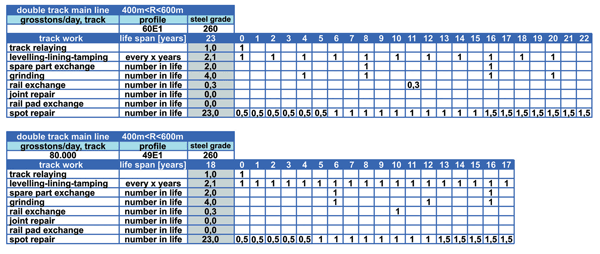

Figure 1: Working cycles for different rail profiles
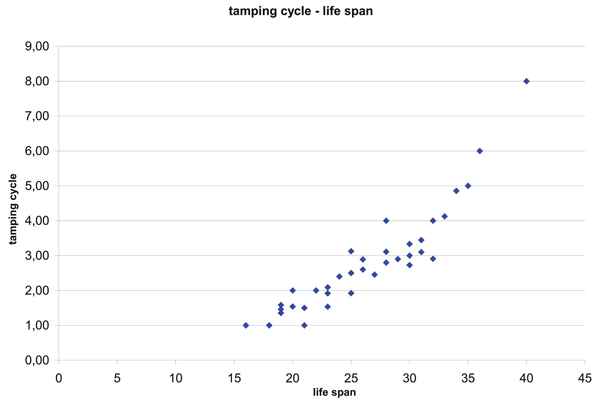

Figure 2: The relation between tamping cycle and life span of track
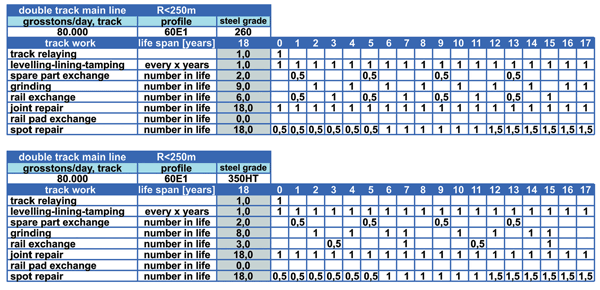

Figure 3: Working cycles for different steel grades


Table 1: reduction of life cycle cost of track superstructure by using R350HT rails
References
- Veit P. : ‘Infrastructure maintenance strategies’, rail international, June 2002
- Veit P. : The ‘Permanent Way Strategy’ project of the Austrian Federal Railways (ÖBB), ZEV rail February 2005 special edition ÖVG
- Veit P.: ‘Research into forecasting the quality development of permanent way’, ZEV rail February 2005 special edition ÖVG
- Veit P, Marschnig, St.: Projekt Stratgie Komponenten Schienen, ÖBB, voestalpine Schienen GmbH, TU Graz, 2005
- Ivo, M.: Investitionsvergleich für den Oberbau des Fahrwegs Eisenbahn basierend auf dessen Instandhaltungskosten entland seines Lebenszyklus, Diplomarbeit TU Graz 2004
- Heyder R., Girsch G.: Testing of HSH-rails in High Speed Tracks to Minimise Rai Damage. Wear, Contact Mechanics and Wear of Rail/Wheel Systems 2003, 258 (2005) 7-8, pp. 1014-1021
- Lichtberger B.: Handbuch Gleis, Tetzlaff Verlag, 2003
- Schöch W., Hayder R.: Rail Surface Grinding: Exploring the Interaction 6th international conference on contact mechanics and wear of rail/wheel systems (CM2003), Gothenburg, Sweden 10-13, 2003
- Schultheiss H. Schienen – ein Teil der Fahrbahn, Eisenbahningenieur 41 (1990) 6, pp 296-300
- Girsch G., Frank N., Pointner P.: New Rail Grades – a Technical Performance Overview, Conference proc. IHHA 2005, 14-16th June, Rio de Janeiro, Brasil
- Jörg A.: Ermüdungsfestigkeit von Schienen, Diplomarbeit TU Graz, 2005
- Hiensch M., Watson A.: ProRail predicts RCF hotspots. Railway Gazetted International, January 2004; pp 38-49.
- Schilder R.: Expertise regarding RCF deflects in the Austrian railway network, in4, 2005
- Subsoil conditions, mainly the problem of drainage is by far the most important cost driver for life cycle cost of superstructure. Good subsoil conditions take into account a defined and functional drainage and sufficient e-moduli of subsoil – meeting the needs of the transport related forces.




